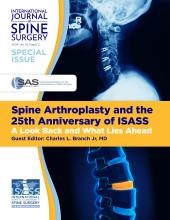ABSTRACT
Background Advances in prehospital life support of patients who have sustained high-energy trauma have resulted in an increase in the number of patients with craniocervical dissociations (CCDs) surviving. With better imaging and more severely injured patients surviving, we are now seeing other associated injuries. CCDs in association with unstable, noncontiguous, subaxial spine injuries have not been described. The objective of this study was to (1) describe this injury pattern and its characteristics, including the mechanism of injury, injury levels, and neurological deficits, and (2) understand prognosis and outcome.
Methods After institutional review board approval, a retrospective study of patients who sustained CCD in association with an unstable, circumferential, subaxial, or cervicothroacic spine injury (C3–T2) between January 1, 2003, and August 31, 2018, was done. Review of imaging was performed to identify spine injury localization and type. Demographic data, mechanism of injury, neurological status, type of treatment, and patient outcomes were obtained from the electronic medical records.
Results One hundred seventeen patients with CCD were identified, of which 105 had full spine radiographs. Thirteen (8 male and 5 female) had an associated, noncontiguous, unstable cervical, or cervicothoracic injury. Mean age was 45.4 ± 19 years. No exam could be obtained in 6; in the other 7, 1 was American Spinal Injury Association (ASIA) E, 1 ASIA D, and 5 ASIA A. Operative management of both injuries was planned for all 13 patients; however, 2 died before surgery. At discharge, there were 9 survivors with mean follow up of 2 years; 4 patients were independent (3 ASIA D, 1 ASIA E), and 5 were dependent (1 ASIA C, 4 ASIA A).
Conclusions Approximately 12% of patients with CCD have a floating cervical spine injury. Floating cervical spine injuries have an unfavorable prognosis with 69% surviving to hospital discharge but only 31% functioning independently (ASIA D or E).
Level of Evidence 4.
Clinical Relevance Floating cervical spine injuries need to be recognized to optimize prognosis, yet even in the best of circumstances, prognosis is guarded.
- spinal cord injury
- craniocervical dissociation
- floating cervical spine
- spine fracture
- spine dislocation
- subaxial dislocation
Footnotes
Disclosures and COI: No benefits in any form have been or will be received from a commercial party related directly or indirectly to the subject of this paper. Author RJB reports outside the submitted work personal fees from Globus and AO Spine for speaking and teaching arrangements and grants from AO Spine for fellowship support. For the remaining authors, none are declared.
- This manuscript is generously published free of charge by ISASS, the International Society for the Advancement of Spine Surgery. Copyright © 2021 ISASS







